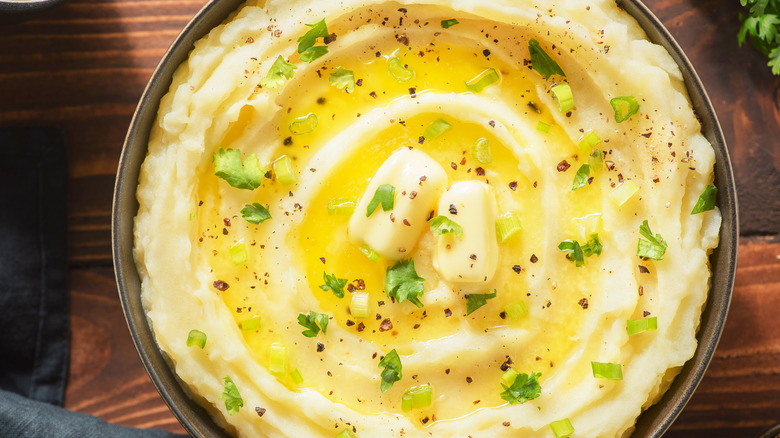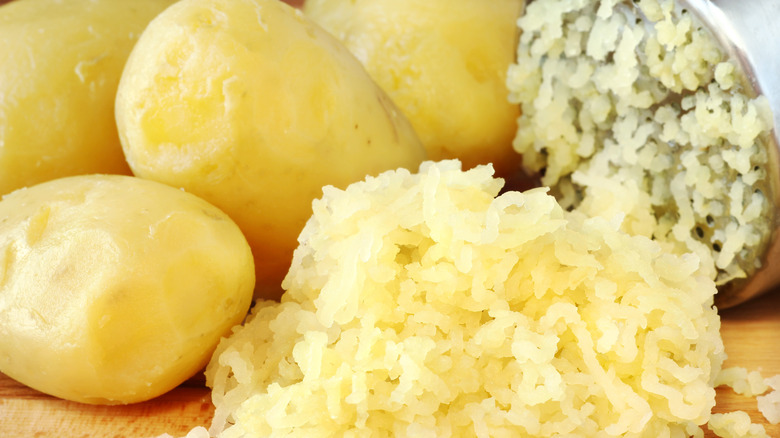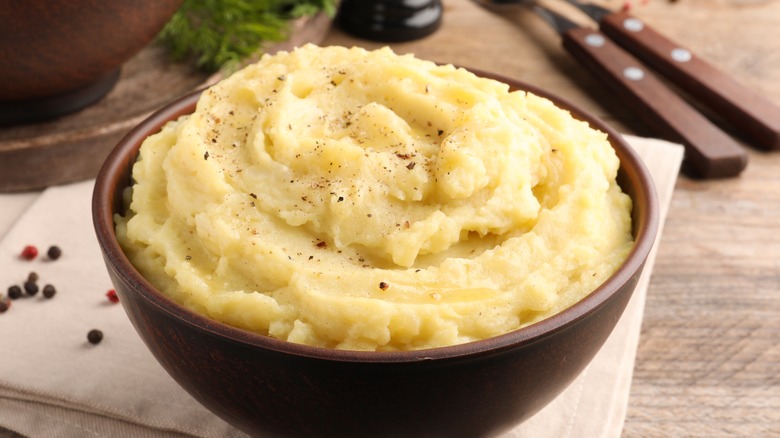A Cooling Rack Is Key To Whipping Up Mashed Potatoes In A Flash
Breaking up a pot of potatoes with a hand masher can be tiring and time-consuming. Even after smashing the tubers repeatedly, you can still be left with uneven clumps ruining what should be a smooth, creamy consistency. For the fluffiest potatoes, you can pull out a potato ricer. This is the best kitchen tool for mashed potatoes, but not everybody has one. It turns out, however, that you don't need it to get a very similar result. Instead, you can accomplish this task with a simple cooling rack.
Just cut a whole boiled potato in half, and then press it through the rack's wire mesh. (Be sure to let the potato cool a little bit before doing so, to avoid burning your hands on a hot spud.) This technique will also speed things up because you don't need to peel the potatoes before passing them through. Instead, the tough skin will be stopped while the soft flesh of the potato moves through freely. Just keep in mind that this method will work best with the russet potatoes, which are generally one of the best potatoes to use for mashing this way. Other varieties like red, yellow, or fingerling have thin skins that may potentially tear and move through the rack.
The benefits of using a cooling rack for fluffy mashed potatoes
The cooling rack method gives you fluffier potatoes because it replicates the conditions of a potato ricer. When using a ricer — or a similar tool like a tamis (AKA a drum sieve) or food mill — you are able to break down your potatoes quickly with minimal force. On the other hand, the more you agitate cooked potatoes, the more starch they will release — and that leads to gummier mashed potatoes.
A potato masher is a great example — it will release tons of starch during the long time it takes you to actually smoosh your taters into submission. A food processor or blender can mess things up even more as the whirring blades cause starch molecules to burst, giving you an even gluier result. The cooling rack method, on the other hand, slices potatoes swiftly and fairly delicately. The only time this won't work is if you're specifically looking for a chunky mash. In that case, stick to the potato masher.
It's also crucial to treat your potatoes correctly to avoid them seizing up and turning tacky. Once they're cooked, always make sure that your tubers are fully dry before mashing them, otherwise they'll become waterlogged. Similarly, always warm up your additional mix-ins (such as butter and cream) before adding them to the pot as adding cold ingredients can throw off the texture.
More shortcuts for the fastest mashed potatoes
One of the best parts about the cooling rack method for mashed potatoes is that it speeds up your preparation time. In order to make things even faster, try cooking the spuds in the microwave rather than boiling. Poke small holes into a whole potato's surface to allow steam to escape during the cooking time, and microwave for about seven minutes or until fork tender. Cutting your potatoes into the right size can also speed things along. Breaking them down into 1- to 2-inch chunks means they'll cook faster. Just don't cut them any smaller than that, as these pieces will end up leaching flavor and absorbing too much water.
Another method is steaming your potatoes, which offers a few key advantages. For one, the small amount of water needed for steaming will come up to temperature much faster than boiling a whole pot of water. Not only will potatoes cook more quickly with this method, but they'll never come into contact with the water this way, so their flavor will be less diluted as well.



